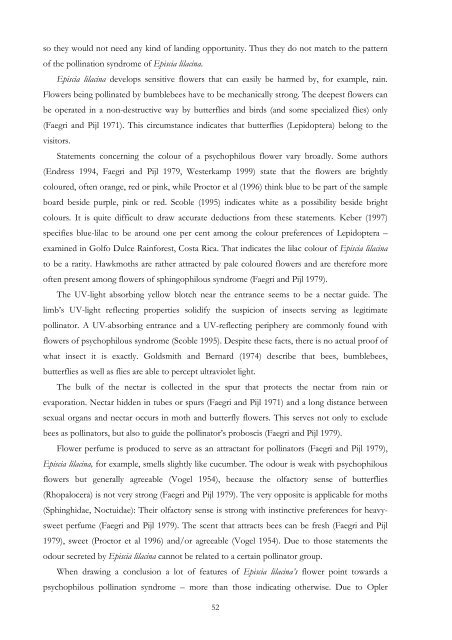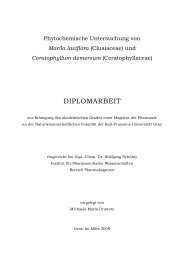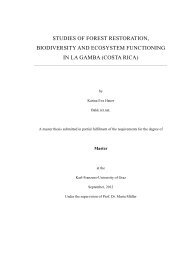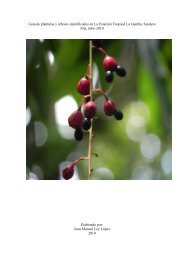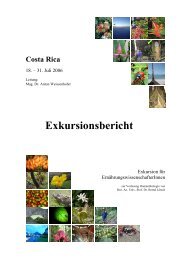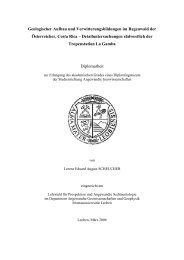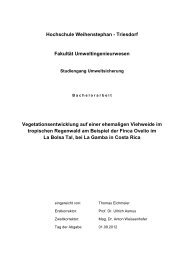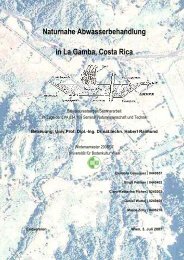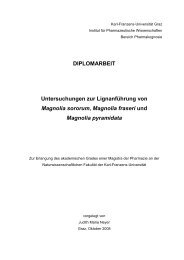Leaf colour patterns, vegetative and sexual reproduction of Episcia ...
Leaf colour patterns, vegetative and sexual reproduction of Episcia ...
Leaf colour patterns, vegetative and sexual reproduction of Episcia ...
Create successful ePaper yourself
Turn your PDF publications into a flip-book with our unique Google optimized e-Paper software.
so they would not need any kind <strong>of</strong> l<strong>and</strong>ing opportunity. Thus they do not match to the pattern<br />
<strong>of</strong> the pollination syndrome <strong>of</strong> <strong>Episcia</strong> lilacina.<br />
<strong>Episcia</strong> lilacina develops sensitive flowers that can easily be harmed by, for example, rain.<br />
Flowers being pollinated by bumblebees have to be mechanically strong. The deepest flowers can<br />
be operated in a non-destructive way by butterflies <strong>and</strong> birds (<strong>and</strong> some specialized flies) only<br />
(Faegri <strong>and</strong> Pijl 1971). This circumstance indicates that butterflies (Lepidoptera) belong to the<br />
visitors.<br />
Statements concerning the <strong>colour</strong> <strong>of</strong> a psychophilous flower vary broadly. Some authors<br />
(Endress 1994, Faegri <strong>and</strong> Pijl 1979, Westerkamp 1999) state that the flowers are brightly<br />
<strong>colour</strong>ed, <strong>of</strong>ten orange, red or pink, while Proctor et al (1996) think blue to be part <strong>of</strong> the sample<br />
board beside purple, pink or red. Scoble (1995) indicates white as a possibility beside bright<br />
<strong>colour</strong>s. It is quite difficult to draw accurate deductions from these statements. Keber (1997)<br />
specifies blue-lilac to be around one per cent among the <strong>colour</strong> preferences <strong>of</strong> Lepidoptera –<br />
examined in Golfo Dulce Rainforest, Costa Rica. That indicates the lilac <strong>colour</strong> <strong>of</strong> <strong>Episcia</strong> lilacina<br />
to be a rarity. Hawkmoths are rather attracted by pale <strong>colour</strong>ed flowers <strong>and</strong> are therefore more<br />
<strong>of</strong>ten present among flowers <strong>of</strong> sphingophilous syndrome (Faegri <strong>and</strong> Pijl 1979).<br />
The UV-light absorbing yellow blotch near the entrance seems to be a nectar guide. The<br />
limb’s UV-light reflecting properties solidify the suspicion <strong>of</strong> insects serving as legitimate<br />
pollinator. A UV-absorbing entrance <strong>and</strong> a UV-reflecting periphery are commonly found with<br />
flowers <strong>of</strong> psychophilous syndrome (Scoble 1995). Despite these facts, there is no actual pro<strong>of</strong> <strong>of</strong><br />
what insect it is exactly. Goldsmith <strong>and</strong> Bernard (1974) describe that bees, bumblebees,<br />
butterflies as well as flies are able to percept ultraviolet light.<br />
The bulk <strong>of</strong> the nectar is collected in the spur that protects the nectar from rain or<br />
evaporation. Nectar hidden in tubes or spurs (Faegri <strong>and</strong> Pijl 1971) <strong>and</strong> a long distance between<br />
<strong>sexual</strong> organs <strong>and</strong> nectar occurs in moth <strong>and</strong> butterfly flowers. This serves not only to exclude<br />
bees as pollinators, but also to guide the pollinator’s proboscis (Faegri <strong>and</strong> Pijl 1979).<br />
Flower perfume is produced to serve as an attractant for pollinators (Faegri <strong>and</strong> Pijl 1979),<br />
<strong>Episcia</strong> lilacina, for example, smells slightly like cucumber. The odour is weak with psychophilous<br />
flowers but generally agreeable (Vogel 1954), because the olfactory sense <strong>of</strong> butterflies<br />
(Rhopalocera) is not very strong (Faegri <strong>and</strong> Pijl 1979). The very opposite is applicable for moths<br />
(Sphinghidae, Noctuidae): Their olfactory sense is strong with instinctive preferences for heavysweet<br />
perfume (Faegri <strong>and</strong> Pijl 1979). The scent that attracts bees can be fresh (Faegri <strong>and</strong> Pijl<br />
1979), sweet (Proctor et al 1996) <strong>and</strong>/or agreeable (Vogel 1954). Due to those statements the<br />
odour secreted by <strong>Episcia</strong> lilacina cannot be related to a certain pollinator group.<br />
When drawing a conclusion a lot <strong>of</strong> features <strong>of</strong> <strong>Episcia</strong> lilacina’s flower point towards a<br />
psychophilous pollination syndrome – more than those indicating otherwise. Due to Opler<br />
52


